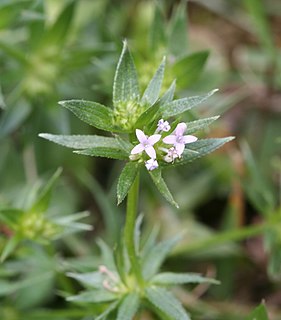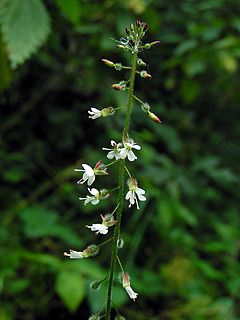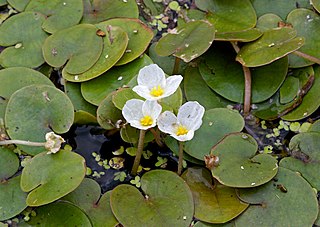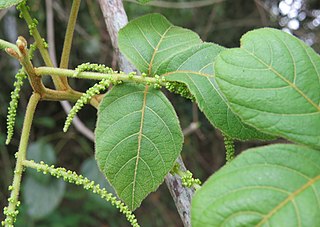
Prunus armeniaca is the most commonly cultivated apricot species. The native range is somewhat uncertain due to its extensive prehistoric cultivation. Genetic studies indicate Central Asia is the center of origin. It is extensively cultivated in many countries and has escaped into the wild in many places.

Lamium (dead-nettles) is a genus of about 30 species of flowering plants in the family Lamiaceae, of which it is the type genus. They are all herbaceous plants native to Europe, Asia, and northern Africa, but several have become very successful weeds of crop fields and are now widely naturalised across much of the temperate world.

Daphne is a genus of between 70 and 95 species of deciduous and evergreen shrubs in the family Thymelaeaceae, native to Asia, Europe and north Africa. They are noted for their scented flowers and often brightly coloured berries. Two species are used to make paper. Many species are grown in gardens as ornamental plants; the smaller species are often used in rock gardens. All parts of daphnes are poisonous, especially the berries.

Cyperus is a large genus of about 700 species of sedges, distributed throughout all continents in both tropical and temperate regions.

Podophyllum is a genus of flowering plant in the family Berberidaceae, native from Afghanistan to China, and from southeast Canada to the central and eastern United States. The genus was first described by Carl Linnaeus in 1753.

Sherardia is a monotypic genus of flowering plants in the family Rubiaceae. The genus contains only one species, viz. Sherardia arvensis or (blue) field madder, which is widespread across most of Europe and northern Africa as well as southwest and central Asia and Macaronesia. It is also reportedly naturalized in Australia, New Zealand, Taiwan, Kerguelen, Ethiopia, Sudan, southern Africa, Mexico, Costa Rica, South America, Bermuda, Cuba, Haiti and much of Canada and the United States.

Coriaria is the sole genus in the family Coriariaceae, which was described by Linnaeus in 1753. It includes 14 species of small trees, shrubs and subshrubs, with a widespread but disjunct distribution across warm temperate regions of the world, occurring as far apart as the Mediterranean region, southern and eastern Asia, New Zealand, the Pacific Ocean islands, and Central and South America.

The Circaea, or enchanter's nightshades, are a genus of flowering plants in the evening primrose family Onagraceae. About two dozen taxa have been described, including eight species. Plants of the genus occur throughout the temperate and boreal forests of the Northern Hemisphere. Three taxa occur in North America: Circaea alpina, Circaea canadensis, and the hybrid Circaea × sterilis. The generic name Circaea refers to the enchantress Circe from Greek mythology who is said to have used the herb as a charm.

Sparganium (bur-reed) is a genus of flowering plants, described as a genus by Linnaeus in 1753. It is widespread in wet areas in temperate regions of both the Northern and Southern Hemispheres. The plants are perennial marsh plants that can grow to 3.5 m, with epicene flowers.

Hydrocharis is a genus of aquatic plants in the family Hydrocharitaceae described as a genus by Carl Linnaeus in 1753. It is widespread across much of Europe and Asia, plus a few scattered locations in Africa. It is also reportedly naturalized in parts of North America.

Tiarella, the foamflowers, is a genus of flowering plants in the family Saxifragaceae. The generic name Tiarella means "little turban", which suggests the shape of the seed capsules. Worldwide there are seven species, one each in eastern Asia and western North America, plus five species in eastern North America. As of October 2022, the taxonomy of Tiarella in eastern North America is in flux.

Erigeron acer is a widespread herbaceous flowering plant in the family Asteraceae. Common names include bitter fleabane and blue fleabane. The species is native to Canada, colder parts of the United States, northern, central, and southeastern Asia, and most of Europe.

Roemeria argemone is a species of flowering plant in the poppy family Papaveraceae. Its common names include long pricklyhead poppy, prickly poppy and pale poppy. Its native range includes parts of Eurasia and North Africa, but it can be found growing wild in parts of North America, where it is an introduced species. It is cultivated as an ornamental plant.

Galium boreale or northern bedstraw is a perennial plant species of the Rubiaceae family. It is widespread over the temperate and subarctic regions of Europe, Asia and North America including most of Canada and the northern United States.

Carex vesicaria is an essentially Holarctic species of sedge known as bladder sedge, inflated sedge, and blister sedge. It has been used to insulate footwear in Norway and among the Sami people, and for basketry in North America.

Pentanema salicinum is a plant species in the family Asteraceae. It is found across Eurasia from Portugal to Japan. It has been reported growing in the wild in a few scattered locations in North America but it has not become widely established there.

Allophylus cobbe, commonly known as titberry or Indian allophylus, is a pantropical, shrub in the family Sapindaceae with many uses in traditional medicine. It has a highly variable morphology throughout its range and may prove to be more than one species.

Prunus ulmifolia is species of Prunus native to Central Asia. It is often treated as a synonym of the East Asian species P. triloba. However, they are distinctly different in leaves, flowers and fruits. P. triloba have slightly trilobed leaves, campanulate calyx tubes, unpitted stones, and fruits splitting when ripe, whereas P. ulmifolia have leaves without lobes, cylindrical calyx tubes, stones finely pitted with irregularly branching furrows, and fruits not splitting.

Rumex vesicarius, also known as Ruby dock, or bladder dock, is a species of perennial flowering plant in the family Polygonaceae. According to Plants of the World Online, Rumex vesicarius is native to tropical and temperate Asia, Africa, and Western Australia. However, the Council of Heads of Australasian Herbaria asserts that within Australia it is naturalised in Western Australia, the Northern Territory, South Australia, Queensland and New South Wales.

Leontice leontopetalum, commonly known as leontice, lion's foot, lion's turnip, and lion's leaf, is a perennial geophyte having a wide distribution, and growing primarily in semi-desert regions. The name "lion's foot" is derived from the Greek λεοντοπέταλη [= "lioness"] in reference to a fancied resemblance between the shape of the leaves and the pads of a lioness’s paw.
























